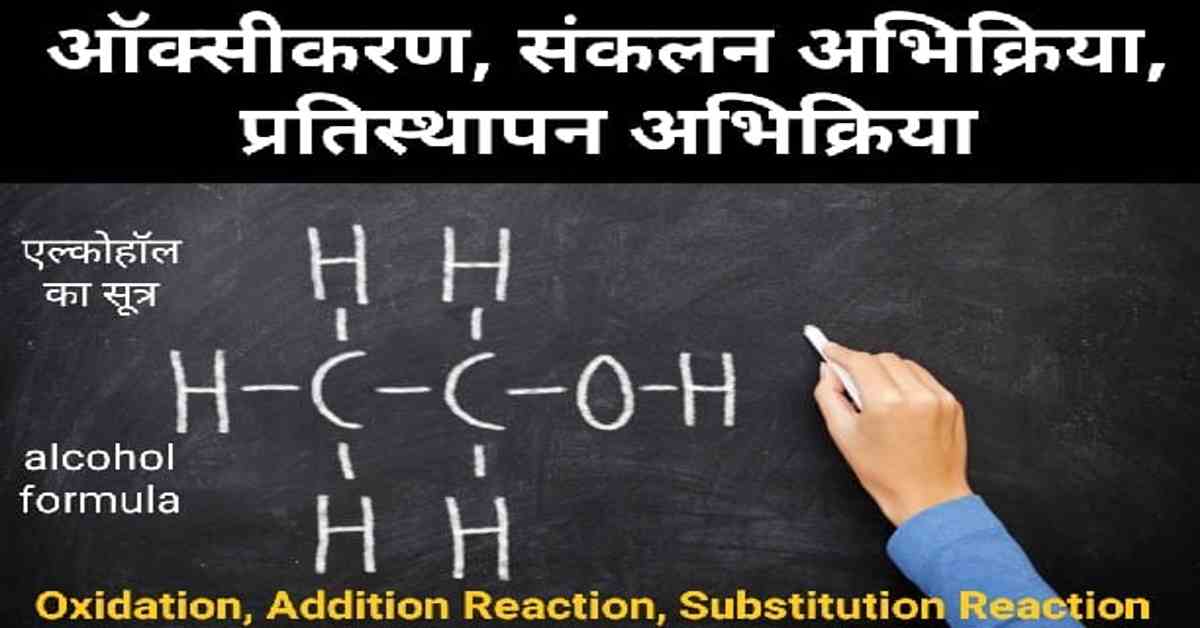
ऑक्सीकरण, संकलन अभिक्रिया, प्रतिस्थापन अभिक्रिया | Oxidation, Addition Reaction, Substitution Reaction
ऑक्सीकरण (Oxidation)
दहन के माध्यम से कार्बनिक यौगिकों को आसानी से ऑक्सीकृत किया जा सकता है। इसे 'पूर्ण ऑक्सीकरण' कहा जाता है। इस रासायनिक अभिक्रिया के अलावा कुछ ऐसी अभिक्रियाएँ होती हैं, जिनके अंतर्गत एल्कोहॉलों को कार्बोक्सिलिक अम्ल में परिवर्तित किया जाता है। इस अभिक्रिया को 'ऑक्सीकरण अभिक्रिया' कहते हैं। कुछ पदार्थों में अन्य पदार्थों को ऑक्सीजन देने की क्षमता होती है। इन पदार्थों को 'ऑक्सीकारक' कहते हैं। क्षारीय पोटेशियम परमैंगनेट या अम्लीकृत पोटैशियम डाइक्रोमेट एल्कोहॉलों को अम्लों में ऑक्सीकृत कर देते हैं। अर्थात् ये आरंभिक पदार्थ में ऑक्सीजन जोड़ते हैं। इन पदार्थों को ऑक्सीकारक कहा जाता है।
उदाहरण– क्षारीय पोटेशियम परमैंगनेट या अम्लीकृत पोटैशियम डाइक्रोमेट एथिल एल्कोहॉल को एथेनोइक अम्ल में ऑक्सीकृत कर देते हैं। इस अभिक्रिया को इस प्रकार समझा जा सकता है–
CH3–CH2–OH →(क्षारीय KMnO4 + ऊष्मा अथवा अम्लीकृत K2Cr2O7 + ऊष्मा)→ CH3COOH
Organic compounds can be easily oxidized through combustion. This is called 'complete oxidation'. Apart from this chemical reaction, there are some such reactions, under which alcohols are converted into carboxylic acids. This reaction is called 'oxidation reaction'. Some substances have the ability to oxygenate other substances. These substances are called 'oxidising agents'. Alkaline potassium permanganate or acidified potassium dichromate oxidise alcohols to acids. That is, they add oxygen to the starting material. These substances are called oxidising agents.
Example– Alkaline potassium permanganate or acidified potassium dichromate oxidise ethyl alcohol to ethanoic acid. This reaction can be understood as–
CH3–CH2–OH →(alkaline KMnO4 + heat or acidified K2Cr2O7 + heat)→ CH3COOH
रसायन विज्ञान के इन 👇 प्रकरणों को भी पढ़ें। (Also read these 👇 episodes of Chemistry.)
कार्बनिक यौगिकों का दहन होने पर क्या होता है? | What Happens When Organic Compounds Are Combusted?
संकलन अभिक्रिया (Addition Reaction)
वे पदार्थ जिनकी वजह से अभिक्रिया भिन्न दर से आगे बढ़ती है, 'उत्प्रेरक' कहलाते हैं। उत्प्रेरक अभिक्रिया को प्रभावित नहीं करते। पैलेडियम या निकेल जैसे उत्प्रेरकों की उपस्थिति में असंतृप्त हाइड्रोकार्बन हाइड्रोजन जोड़कर संतृप्त हाइड्रोकार्बन में परिवर्तित हो जाते हैं। इस अभिक्रिया को 'संकलन अभिक्रिया' कहा जाता है। निकेल उत्प्रेरक का प्रयोग कर सामान्यतः वनस्पति तेलों का हाइड्रोजनीकरण किया जाता है। यह अभिक्रिया संकलन अभिक्रिया के अंतर्गत आती है। वनस्पति तेलों में लम्बी असंतृप्त कार्बन श्रृंखलाएँ होती हैं। जंतु वसा में संतृप्त कार्बन श्रृंखलाएँ होती हैं। वनस्पति तेल स्वास्थ्यवर्धक होते हैं। जंतु वसा स्वास्थ्य के लिए हानिकारक होते हैं, क्योंकि जंतु वसा में संतृप्त वसा अम्ल होते हैं। भोजन पकाने के लिए असंतृप्त वसा अम्लों वाले तेलों का प्रयोग करना चाहिए।
उदाहरण– निखिल उत्प्रेरक और हाइड्रोजन की उपस्थिति में असंतृप्त हाइड्रोकार्बन हाइड्रोजन जोड़ लेता है। इससे संतृप्त हाइड्रोकार्बन प्राप्त होता है। इस अभिक्रिया को इस प्रकार समझा जा सकता है–
CR2=CR2 →(निकेल उत्प्रेरक और H2)→ CHR2–CHR2
The substances due to which the reaction proceeds at a different rate are called 'catalyst'. Catalysts do not affect the reaction. Unsaturated hydrocarbons are converted to saturated hydrocarbons by adding hydrogen in the presence of catalysts such as palladium or nickel. This reaction is called 'aggregation reaction'. Hydrogenation of vegetable oils is generally carried out using nickel catalysts. This reaction comes under the addition reaction. Vegetable oils have long unsaturated carbon chains. Animal fats have saturated carbon chains. Vegetable oils are healthy. Animal fats are injurious to health, as animal fats contain saturated fatty acids. Oils containing unsaturated fatty acids should be used for cooking.
Example– Nikhil adds hydrogen to an unsaturated hydrocarbon in the presence of a catalyst and hydrogen. This gives saturated hydrocarbons. This reaction can be understood as–
CR2=CR2 →(nickel catalyst and H2)→ CHR2–CHR2
रसायन विज्ञान के इन 👇 प्रकरणों को भी पढ़ें। (Also read these 👇 episodes of Chemistry.)
कार्बनिक यौगिकों की नामपद्धति | Nomenclature Of Organic Compounds
प्रतिस्थापन अभिक्रिया (Substitution Reaction)
संतृप्त हाइड्रोकार्बन बहुत कम अभिक्रियाएँ करते हैं। ये अधिकांश अभिकर्मकों की उपस्थिति में अक्रिय होते हैं। जब संतृप्त हाइड्रोकार्बनों को सूर्य के प्रकाश में लाया जाता है, तो ये तीव्र गति से अभिक्रियाएँ करने लगते हैं। कई बार सूर्य के प्रकाश की उपस्थिति में संतृप्त हाइड्रोकार्बन और क्लोरीन की अभिक्रिया होती है। इस अभिक्रिया में क्लोरीन का हाइड्रोकार्बन में संकलन होता है। क्लोरीन एक-एक करके हाइड्रोजन के परमाणुओं का प्रतिस्थापन करता है। इसे 'प्रतिस्थापन अभिक्रिया' कहा जाता है। इस अभिक्रिया में एक प्रकार का परमाणु अथवा परमाणुओं के समूह दूसरे का स्थान लेते हैं। सामान्यतः उच्च समजातीय एल्केन के साथ अनेक उत्पादों का निर्माण होता है।
उदाहरण– सूर्य के प्रकाश की उपस्थिति में मेथेन और क्लोरीन की अभिक्रिया होने पर क्लोरो मेथेन और हाइड्रोक्लोरिक अम्ल प्राप्त होते हैं। इस अभिक्रिया को इस प्रकार समझा जा सकता है–
CH4 + Cl2 →(सूर्य का प्रकाश)→ CH3Cl + HCl
Saturated hydrocarbons undergo very few reactions. These are inert in the presence of most reagents. When saturated hydrocarbons are exposed to sunlight, they react rapidly. Sometimes the reaction of saturated hydrocarbons and chlorine takes place in the presence of sunlight. In this reaction chlorine is added to hydrocarbons. Chlorine substitutes hydrogen atoms one by one. This is called 'substitution reaction'. In this reaction one type of atom or group of atoms takes the place of another. Generally many products are formed with highly homologous alkenes.
Example– When methane and chlorine react in the presence of sunlight, chloromethane and hydrochloric acid are obtained. This reaction can be understood as–
CH4 + Cl2 →(sunlight)→ CH3Cl + HCl
रसायन विज्ञान के इन 👇 प्रकरणों को भी पढ़ें। (Also read these 👇 episodes of Chemistry.)
कार्बनिक यौगिकों की समजातीय श्रेणी | Homologous Series Of Organic Compounds
आशा है, उपरोक्त जानकारी उपयोगी एवं महत्वपूर्ण होगी।
(I hope the above information will be useful and important. )
Thank you.
R. F. Tembhre
(Teacher)
pragyaab.com




Comments